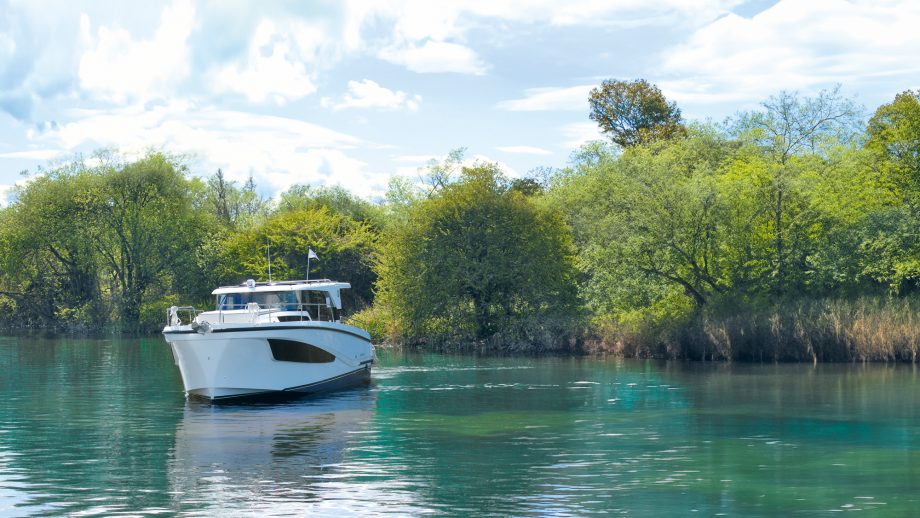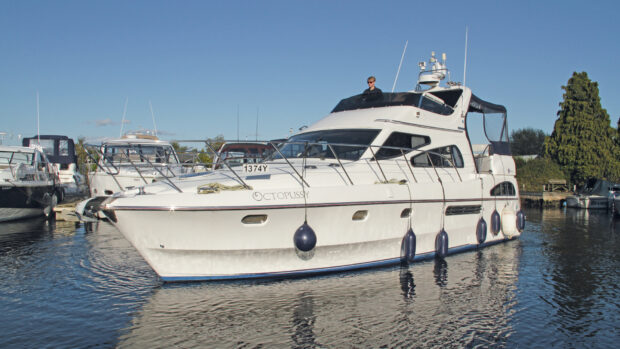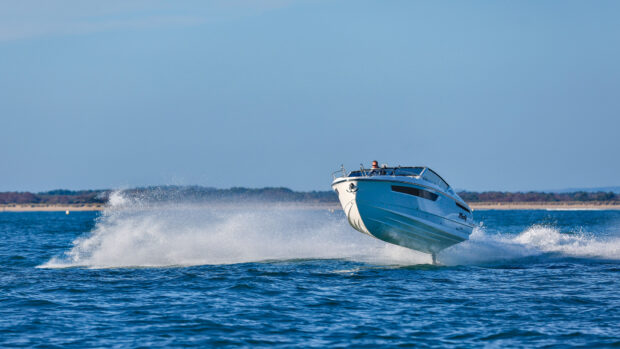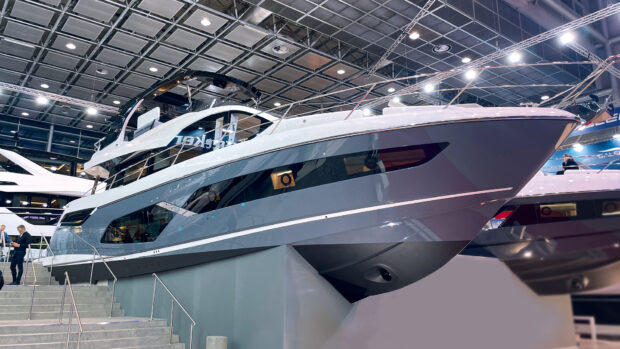If you’re happy to trade speed for serenity, the Delphia 10 Sedan is something that’s likely to appeal to you. Alex Smith takes it for a test drive
What is the point of speed? It can be quite a disarming question for a powerboater but it’s one that needs asking. After all, while speed can save time and provide a bit of sporting exhilaration, even those of us with fast planing boats tend to cruise at moderate speeds to save fuel, and the market increasingly reflects that.
The continued boom in trawler yachts and sedate but spacious cruising cats suggests that the public sees more value in simply being afloat with friends in sustainable comfort than in charging to the next anchorage at 40 knots. And that’s exactly where a boat like the new Delphia 10 Sedan is likely to find its fan base.
Sitting alongside Dutch barges, steel narrowboats and diminutive fibreglass day cruisers at a picturesque pontoon in the Thames and Kennet Marina, it looks nothing like your average inland cruiser. With its low-profile roofline, its inverted screen, its raised hull sides and its tinted glazing, it’s far more dynamic than that. You might even say it has the look of a four-season adventure boat from the likes of Quarken or Wellcraft but there are, of course, some key differences here.

A low roofline makes it easy to squeeze beneath the bridges of Europe’s inland waterways
The hull is designed for displacement and the Delphia takes full advantage of that with all kinds of volume, particularly in the forward quarters. The absence of outboard engines also creates a full-beam swim platform aft of the cockpit.
And if you look beneath the saloon deck, you’ll find that the test boat’s engine option is in fact a single Yanmar 110hp diesel. You can opt instead for a 45hp or 75hp diesel or you can go full electric, but here, with the juiciest powerplant, we have about 9 knots to play with – and we’re going to play with them right now…

Big side decks steal some of the space but there’s still room for a large convertible dinette and a long starboard galley
Out and about
The first thing you notice when you step in at the helm station is how vertical the dash is. It stands virtually bolt upright and it encourages you to do the same. In spite of a slightly hard-edged bolster, it’s a comfy spot too with good all-round visibility and easy access to the external decks.
But because of the unusual dash shape, there’s nowhere sensible to put a cup or a phone unless you reach across to the table at the port dinette. That’s no stress of course, particularly at 5 knots, but it would be worth investigating a rotating seat so you could face over towards the dinette and become a more active member of the party.

If you’re content with 4 knots you can cruise all day with just 1L per hour disappearing from your tank
In terms of the dynamics, there’s no hump to spoil your trim as you accelerate. On the contrary, whether you’re doing 2 knots or 8, you run nice and flat, keeping the views over the elevated foredeck sunbed usefully unobstructed.
It’s only right at the 9-knot top end that we experience any bow lift but even then, that’s merely a consequence of the stern sucking at the shallow river bed as the increased pace creates low pressure beneath the hull. It’s not a concern and it’s not something that would happen if you chose to run flat out in deeper water.
Article continues below…
As for the handling, well on the face of it, a single shaft drive with modest power on a fibreglass boat with decent topsides sounds like a recipe for trouble in a tight marina with a stiff wind blowing. But with wraparound side decks, a skipper’s side door, a starboard side gate, a port window and thrusters both for bow and stern, this is about as simple as a solo helming experience gets on a compact pilothouse-equipped boat.
And it’s very user-friendly in terms of its cruising grounds too. Though the online specs don’t explicitly confirm it, we’re assured by the guys at Tingdene Marinas & Boat Sales that this, like the rest of the boats in the Delphia fleet, is a Cat B platform, so cruising the coastline ought to pose no problem at all.
Of course, the forward hull shape does look like it could be a bit hard-riding in a swell but the fact you’ll be cruising at 6 rather than 26 knots helps mitigate any firmness. And in all cases, having spoken to a couple of Delphia owners who have taken their boats across the Channel, it’s certain that this boat will prove a great deal more practical at sea than your offshore planing boat would prove inland.

The secure wraparound cockpit bench features a reversible central backrest so you can face aft
And so we come to that most critical of issues – efficiency. Sadly, our test boat was rigged for inland work so there was no MFD fitted and the engine display included no data on fuel flow so we can’t be categorical in our assessment. But if it echoes the cruising efficiency of the larger BluEscape 1200 Fly that we tested back in 2020, this is going to be a very affordable boat to run.
Equipped with similar power, the larger flybridge model achieved a fuel flow of just 0.4 litres per mile at 5 knots, rising to 1 litre at 7 knots and 2 litres at 9 knots. Even if we err on the side of caution then, it’s reasonable to assume then that this smaller, lighter, non-fly model should easily provide a 5-knot cruise at 0.4L per mile for a range from the 285L tank of around 570 miles and the manufacturer’s test figures fully back that up.
In fact, they suggest that your fuel flow will only rise to 0.7L/Nm at 6 knots and 1.5L at 8 knots. But if you’re happy to drop it to 4 knots (and on a displacement craft, why wouldn’t you be) then you can run on just a litre per hour or 0.25L/Nm.
So if you had a full day at sea, comprising five hours of sitting at anchor and five hours (20 miles) of cruising, your entire trip would cost you just 5 litres of fuel – and however you feel about speed, that represents a spectacular return on your investment.

A bulbous island sunbed does wonderful things for the volume in the forward cabin
Space and flexibility
An overall length of 32ft is not a lot to play with, particularly as the Delphia lavishes so much space on the walkaround side decks. But both the volume and the way it’s arranged provide much more than you would expect of a boat of this length.
The raised port side deck, for instance, collaborates with the elevated furniture on the port side of the saloon to provide all the space you need for a second cabin. If you have kids or you enjoy cruising with a guest or two, you can spec it with a second double berth, complete with changing room and hanging storage. But if you like to cruise as a couple, you can just as easily spec this space as an office; as a utility room for washing machines, driers and extra storage; or as a combination of the two.

Light and volume in the bow cabin are remarkable
Up at the bow, things are equally well considered. Now on the face of it, the massively elevated foredeck coachroof, topped with equally oversized sunbed cushions, seems like an odd choice. It takes the leading edge of the deck moulding way above the level of the cushions on the anchor hatches in the forepeak so its value as a forward lounge is limited; and in aesthetic terms, this elevated section has all the subtlety of a hippo in your living room. But its value is very significant because in addition to creating a big lounging space forward, it also creates a truly cavernous bow cabin.
That cabin includes a raised scissor berth that’s easily converted between a double and a pair of singles. There’s also plenty of storage and thanks to the big windows and bright fuss-free fibreglass bulkheads, you feel every cubic inch of this space to the utmost.
As you make your way back up into the pilothouse, past a lofty starboard bathroom with separate shower compartment, the saloon also feels pretty good. The Delphia’s low roofline is designed to enable you to fit beneath the bridges of Europe’s inland waterways network and the roof’s large, rigorously flat rectangular surface is tailor-made either for water toys or for an enormous solar array to help make you more independent of shoreside facilities. But there’s still plenty of headroom inside for a six-footer.

The starboard cabin adds real flexibility to the mix
There’s a long starboard galley in here too with a gas hob, plenty of storage, some magnetic spice jars and a neat slide-out chopping board. And at the aft end, sliding patio doors open out onto a symmetrical aft cockpit featuring a central dinette with a reversible backrest, so you can face aft and watch the kids or enjoy the view.
It’s not especially clever by modern cockpit standards but it’s safe for a family, there’s lots of storage, there’s good overhead shelter and there’s plenty of open deck space to make on board movement simple.
Delphia 10 Sedan specifications
LOA: 32ft 1in (9.78m)
BEAM: 11ft 6in (3.49m)
DRAFT: 2ft 7in (0.8m)
AIR DRAFT: 8ft 4in (2.55m)
DISPLACEMENT: 6,270 kg
FUEL CAPACITY: 285 litres
ENGINE: Single shaft-drive 2L, 4-cylinder Yanmar 4JH110 diesel
RCD: C10
CONTACT: delphiayachts.com
Delphia 10 Sedan costs & options
From: £185,947 inc VAT Test boat
includes the following options…
Bow and stern thrusters: £9,913
Bow lounge pack, inc awning: £2,734
Diesel heating: £5,322
White oak interior: £2,087
Cockpit enclosure system: £3,339
Lounge trim package: £16,800
 If you enjoyed this….
If you enjoyed this….
Motor Boat & Yachting is the world’s leading magazine for Motoryacht enthusiasts. Every month we have inspirational adventures and practical features to help you realise your sailing dreams, as well as tests and news of all the latest motorboats.
Plus you’ll get our quarterly Custom Yachting supplement where we share the last on offer in the superyacht world and at the luxury end of the market.
Build your knowledge with a subscription delivered to your door. See our latest offers and save at least 30% off the cover price.
Price as reviewed:
£185,947.00 As tested inc. VAT
Verdict
As our day in the slow lane ebbs to a genteel conclusion, it’s impossible to say we haven’t enjoyed ourselves. We absolutely have. It’s been serene and comfortable, quiet and stress-free. We’ve had time to peruse bankside buttercups and meandering dragon flies. We’ve enjoyed the novice-friendly controllability of the boat, the surprising volume of the internal spaces and the unhurried flow of the deck spaces. We’ve enjoyed the quietude, the frugality and the absence of fumes. And as we tie up alongside, it strikes us that this is one of those boats that is content to take a back seat. It enables you to immerse yourself in the boating experience without playing the lead role. It doesn’t force itself upon your consciousness with big impacts or neon accents or intrusive V8 rasps. It doesn’t get in the way with ingenious ‘look-at-me’ features. It merely facilitates your day out in a very competent and unassuming fashion. Of course, if you’re a committed sportsboater, you might still baulk at the idea of paying a quarter of a million pounds for a 32ft boat that tops out at 9 knots. But given its style, volume, easygoing running costs and flexibility of application, you have to concede that the new Delphia 10 Sedan represents a huge amount of boat (and a huge amount of enjoyment) for the money.




 If you enjoyed this….
If you enjoyed this….





